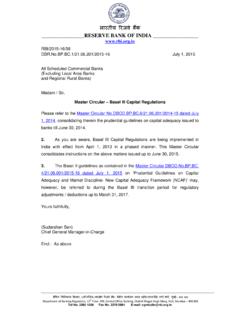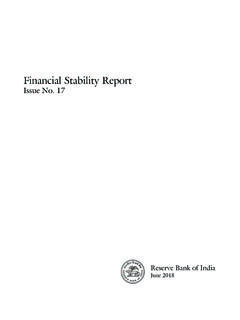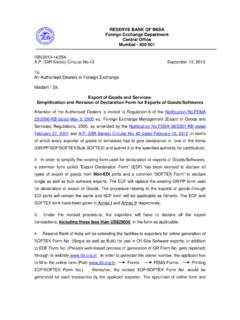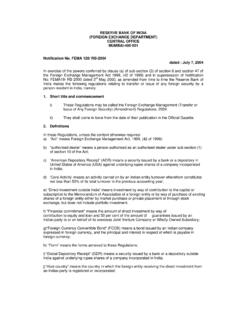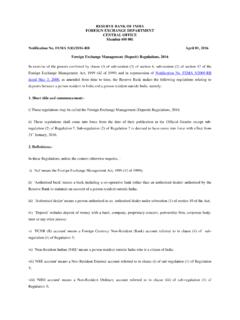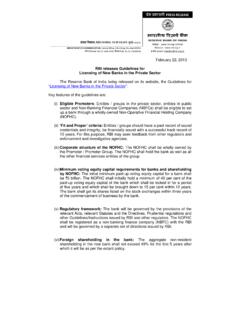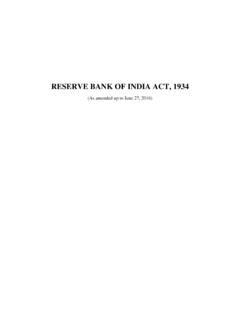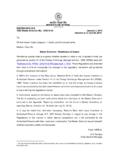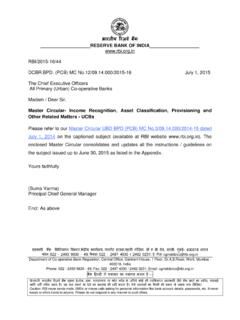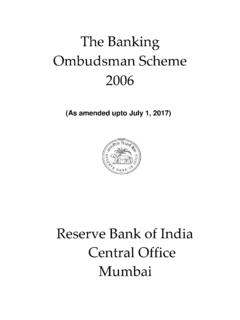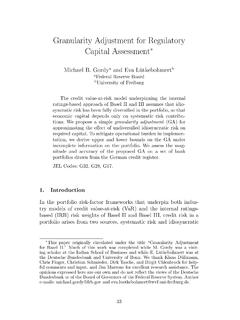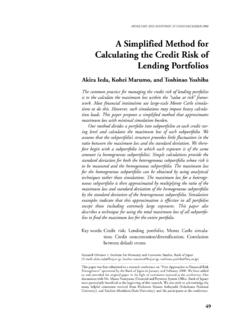Transcription of RESERVE BANK OF INDIA - RBI
1 { _____RESERVE bank OF INDIA of Banking Operations and Development, Central Office, 12th floor, Central Office Building, ShahidBhagat Singh Marg, Mumbai - 400001 Tel No: 22661602 Fax No: 22705691 E-mail: /2014-15 July 1, 2014 All Commercial Banks(Excluding Local Area Banks and Regional Rural Banks)Dear Sir,Master Circular - Prudential Guidelines on Capital Adequacy and Market Discipline -New Capital Adequacy Framework (NCAF)Please refer to theMaster Circular dated July 1, 2013,consolidating therein the guidelines issued to banks till that date on aforesaid Master Circular has been suitably updated by incorporating relevantinstructions issued upto June 30, 2014 listed in Annex 16 and has been placed on the RBIwebsite ( ).}
2 3. This Master Circular does not cover the guidelines on Basel III capital regulations whichare consolidated in the Master Circular dated July 1,2014 on Basel III Capital Regulations .4. The guidelines in this Master Circular have limited relevance only for the purpose oftransitional arrangements provided for regulatory adjustments/deductions upto March 31,2017 as stated in the Master Circular on Basel III Capital Regulations referred in paragraph3 above. It is emphasized that capital adequacy has to be maintained in terms of the MasterCircular on Basel III Capital Regulations faithfully,(Sudarshan Sen)Chief General ManagerEncl: As above1 TABLE OF CONTENTSPart A : Minimum Capital Requirement (Pillar 1)1 Introduction2 approach to Implementation & Effective Date3 Scope of Application4 Capital Elements of Tier I Elements of Tier II Deductions from Capital5 Capital Charge for Credit Claims on Domestic Claims on Foreign Claims on Public Sector Claims on MDBs.
3 BIS and Claims on Claims on Primary Claims on Claims included in the Regulatory Retail Claims secured by Residential Claims secured by Commercial Real Non-Performing Specified Other Off-Balance Sheet Non-Market-related Off-balance Sheet Market-related Off-balance Sheet Current Exposure Failed Securitisation Deduction of Securitisation Exposures from Capital Implicit Application of External Risk-weighted Securitisation Off-balance Sheet Securitisation Recognition of Credit Risk Liquidity Exposures/Synthetic Securitisation/Securitisation with Revolving Structures (with or withoutearly amortization features) Adequacy Requirements for Credit Default Swaps (CDS)
4 Position in Banking Recognition of External/Third Party CDS Internal Hedges6 External Credit Eligible Credit Rating Scope of Application of External Mapping Long Term Short Term Use of Unsolicited Use of Multiple Rating Applicability of Issue rating to Issuer/other claims7 Credit Risk General Legal Credit Risk Mitigation techniques Collateralised Overall framework and minimum The Comprehensive Eligible Financial Calculation of Capital Adequacy Framework for Repo-/Reverse Credit Risk Mitigation techniques On balance Sheet Credit Risk Mitigation techniques Operational requirements for Additional operational requirements for Range of Eligible Guarantors (counter-guarantors)
5 Risk Proportional Currency Sovereign guarantees and Maturity Definition of Risk weights for Maturity Treatment of pools of CRM Techniques8 Capital Charge for Market Scope and Coverage of Capital Charge for Market Measurement of Capital Charge for Interest Rate Measurement of Capital Charge for Equity Measurement of Capital Charge for Foreign Exchange Measurement of Capital Charge for CDS in Trading Market Risk for Exposure to Reference Charge for Counterparty Credit of Exposures below Materiality Thresholds of Aggregation of the Capital Charge for Market Treatment of illiquid positions9 Capital charge for Operational Definition of Operational The Measurement The Basic Indicator ApproachPart B : Supervisory Review and Evaluation Process (Pillar 2)10 Introduction to Supervisory Review and Evaluation Process (SREP)11 Need for improved risk management12 Guidelines for SREP of the RBI and the ICAAP of the The Conduct of the SREP by the The Structural Aspects of the Review of ICAAP ICAAP to be an integral part of the mgmt.
6 & decision making The principle of Regular independent review and ICAAP to be a forward looking ICAAP to be a risk based process ICAAP to include stress tests and scenario analysis Use of capital models for ICAAP13 Select operational aspects of ICAAPPart C : Market Discipline (Pillar 3) Achieving Appropriate Interaction with Accounting Scope and Frequency of Proprietary and Confidential General Disclosure Scope of Application Effective Date of Disclosures Revisions to Pillar III The disclosure requirementsTable DF - 1 Scope of ApplicationTable DF 2 Capital StructureTable DF 3 Capital AdequacyTable DF 4 Credit Risk: General Disclosures for All BanksTable DF 5 Credit Risk: Disclosures for Portfolios subject to theStandardised ApproachTable DF 6 Credit Risk Mitigation: Disclosures for StandardisedApproachTable DF 7 Securitisation.
7 Disclosure for Standardised ApproachTable DF 8 Market Risk in Trading BookTable DF 9 Operational Risk Table DF 10 Interest Rate Risk in the Banking Book (IRRBB)AnnexureAnnex 1 Terms and Conditions applicable to Innovative Debt Instruments forinclusion as Tier I capitalAnnex 2 Terms and Conditions applicable to Perpetual Non-CumulativePreference Shares (PNCPS)Annex 3 Terms and Conditions applicable to Debt Instruments to qualify forinclusion as Upper Tier II capitalAnnex 4 Terms and Conditions applicable to PCPS / RNCPS / RCPS as part ofUpper Tier II capitalAnnex 5 Issue of Subordinated Debt for raising lower Tier II capitalAnnex 6 Extracts from the guidelines on Securitisation of Standard AssetsAnnex 6A Extracts from the Revision to Guidelines on Securitisation TransactionsAnnex 6 BGuidelines on Reset of Credit Enhancements in SecuritisationTransactionsAnnex 7 Illustrations on Credit Risk Mitigation4 Annex 8 Measurement of capita charge for Market Risks in respect of InterestRate 9An Illustrative approach for Measurement of Interest Rate Risk in theBanking Book (IRRBB)
8 Under Pillar IIAnnex 10 The Standardised interest Rate ShockAnnex 11 An example of a Standardised FrameworkAnnex 12 Interest Rate Risk Measurement TechniquesAnnex 13 Monitoring of Interest Rate Risk by Supervisory AuthoritiesAnnex 14 An Illustrative outline of the ICAAPA nnex 15 GlossaryAnnex 16 List of Circulars Consolidated5 Master Circular on Prudential Guidelines on Capital Adequacy and Market Discipline New Capital Adequacy Framework (NCAF)Part A: Guidelines on Minimum Capital With a view to adopting the Basle Committee on Banking Supervision (BCBS)framework on capital adequacy which takes into account the elements of credit risk invarious types of assets in the balance sheet as well as off-balance sheet business and alsoto strengthen the capital base of banks, RESERVE bank of INDIA decided in April 1992 tointroduce a risk asset ratio system for banks (including foreign banks) in INDIA as a capitaladequacy measure.
9 Essentially, under the above system, the balance sheet assets, non-funded items and other off-balance sheet exposures are assigned prescribed risk weightsand banks have to maintain unimpaired minimum capital funds equivalent to the prescribedratio on the aggregate of the risk weighted assets and other exposures on an ongoing bank has issued guidelines to banks in June 2004 on maintenance of capitalcharge for market risks on the lines of Amendment to the Capital Accord to incorporatemarket risks issued by the BCBS in The BCBS released the "International Convergence of Capital Measurement andCapital Standards: A Revised Framework" on June 26, 2004. The Revised Framework wasupdated in November 2005 to include trading activities and the treatment of double defaulteffects and a comprehensive version of the framework was issued in June 2006incorporating the constituents of capital and the 1996 amendment to the Capital Accord toincorporate Market Risk.
10 The Revised Framework seeks to arrive at significantly more risk-sensitive approaches to capital requirements. The Revised Framework provides a range ofoptions for determining the capital requirements for credit risk and operational risk to allowbanks and supervisors to select approaches that are most appropriate for their operationsand financial to Implementation, Effective date and Parallel The Revised Framework consists of three-mutually reinforcing Pillars, viz. minimumcapital requirements, supervisory review of capital adequacy, and market discipline. UnderPillar 1, the Framework offers three distinct options for computing capital requirement forcredit risk and three other options for computing capital requirement for operational options for credit and operational risks are based on increasing risk sensitivity andallow banks to select an approach that is most appropriate to the stage of development ofbank's operations.
